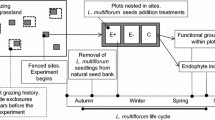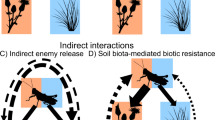Abstract
Reducing the biological diversity of a community may decrease its resistance to invasion by exotic species. Manipulative experiments typically support this hypothesis but have focused mainly on one trophic level (i.e., primary producers). To date, we know little about how positive interactions among species may influence the relationship between diversity and invasibility, which suggests a need for research that addresses the question: under what conditions does diversity affect resistance to invasion? We used experimental manipulations of both plant diversity and the presence of an endophytic fungus to test whether a fungal mutualist of an invasive grass species (Lolium arundinaceum) switches the relationship between plant community diversity and resistance to invasion. Association with the fungal endophyte (Neotyphodium coenophialum) increased the ability of L. arundinaceum to invade communities with greater species diversity. In the absence of the endophyte, the initial diversity of the community significantly reduced the establishment of L. arundinaceum. However, establishment was independent of initial diversity in the presence of the endophyte. Fungal symbionts, like other key species, are often overlooked in studies of plant diversity, yet their presence may explain variation among studies in the effect of diversity on resistance to invasion.




Similar content being viewed by others
References
Ball DM, Pedersen JF, Lacefield GD (1993) The tall fescue endophyte. Am Sci 81:370–379
Bertness MD, Callaway R (1994) Positive interactions in communities. Trends Ecol Evol 9:191–193
Breen JP (1994) Acremonium/endophyte interactions with enhanced plant resistance to insects. Annu Rev Entomol 39:402–423
Brown RL, Peet RK (2003) Diversity and invasibility of southern Appalachian plant communities. Ecology 84:32–39
Bruno JF, Stachowicz JJ, Bertness MD (2003) Inclusion of facilitation into ecological theory. Trends Ecol Evol 18:119–125
Burke MJW, Grime JP (1996) An experimental study of plant community invasibility. Ecology 77:776–790
Callaway RM, Thelen GC, Barth S, Ramsey PW, Gannon JE (2004) Soil fungi alter interactions between the invader Centaurea maculosa and North American natives. Ecology 85:1062–1071
Carey EV, Marler MJ, Callaway RM (2004) Mycorrhizae transfer carbon from a native grass to an invasive weed: evidence from stable isotopes and physiology. Plant Ecol 172:133–141
Chapin FS et al (1998) Ecosystem consequences of changing biodiversity—experimental evidence and a research agenda for the future. Bioscience 48:45–52
Chapin FS et al (2000) Consequences of changing biodiversity. Nature 405:234–242
Chu-chou M et al (1992) Suppression of mycorrhizal fungi in fescue by the Acremonium coenophialum endophyte. Soil Biol Biochem 24:633–637
Clark EM, White JF, Patterson RM (1983) Improved histochemical techniques for the detection of Acremonium coenophialum in tall fescue and methods of in vitro culture of the fungus. J Microb Methods 1:149–155
Clay K (1989) Clavicipitaceous endophytes of grasses: their potential as biocontrol agents. Mycol Res 92:1–12
Clay K (1996) Interactions among fungal endophytes, grasses and herbivores. Res Popul Ecol 38:191–201
Clay K, Holah J (1999) Fungal endophyte symbiosis and plant diversity in successional fields. Science 285:1742–1744
Clay K, Schardl C (2002) Evolutionary origins and ecological consequences of endophyte symbiosis with grasses. Am Nat 160:S99–S127
Clay K, Cheplick GP, Marks S (1989) Impact of the fungus Balansia henningsiana on Panicum agrostoides: frequency of infection, plant growth and reproduction, and resistance to pests. Oecologia 80:374–380
Clay K, Marks S, Cheplick GP (1993) Effects of insect herbivory and fungal endophyte infection on competitive interactions among grasses. Ecology 74:1767–1777
Conover WJ, Iman RL (1981) Rank transformations as a bridge between parametric and nonparametric statistics. Am Stat 35:124–133
Efron B, Tibshirani R (1993) An introduction to the bootstrap. Chapman and Hall, New York
Elmi AA, West CP (1995) Endophyte infection effects on stomatal conductance, osmotic adjustment and drought recovery of tall fescue. New Phytol 131:61–67
Foster BL, Smith VH, Dickson TL, Hildebrand T (2002) Invasibility and compositional stability in a grassland community: relationships to diversity and extrinsic factors. Oikos 99:300–307
Gwinn KD, Gavin AM (1992) Relationship between endophyte infection level of tall fescue seed lots and Rhizoctonia zeae seedling disease. Plant Dis 76:911–914
Hector A et al (2000) Response to Huston et al., No consistent effect of plant diversity on productivity. Science 289:1255a
Hector A, Dobson K, Minns A, Bazeley-White E, Lawton JH (2001) Community diversity and invasion resistance: an experimental test in a grassland ecosystem and a review of comparable studies. Ecol Res 16:819–831
Hiatt EEI, Hill NS (1997) Neotyphodium coenophialum mycelial protein and herbage mass effects on ergot alkaloid concentration in tall fescue. J Chem Ecol 23:2721–2736
Hill NS, Pachon JG, Bacon CW (1996) Acremonium coenophialum-mediated short- and long-term drought acclimation in tall fescue. Crop Sci 36:665–672
Huston MA (1997) Hidden treatments in ecological experiments: re-evaluating the ecosystem function of biodiversity. Oecologia 110:449–460
Kennedy TA, Naeem S, Howe KM, Knops JMH, Tilman D, Reich P (2002) Biodiversity as a barrier to ecological invasion. Nature 417:636–638
Klironomos JN, McCune J, Hart M, Neville J (2000) The influence of arbuscular mycorrhizae on the relationship between plant diversity and productivity. Ecol Lett 3:137–141
Leuchtmann A (1992) Systematics, distribution, and host specificity of grass endophytes. Nat Toxins 1:150–162
Levine JM (2000) Species diversity and biological invasions: relating local process to community pattern. Science 288:852–854
Levine JM (2001) Local interactions, dispersal, and native and exotic plant diversity along a California stream. Oikos 95:397–408
Levine JM, D’Antonio CM (1999) Elton revisited: a review of evidence linking diversity and invasibility. Oikos 87:15–26
Levine JM, Vila M, D’Antonio CM, Dukes JS, Grigulis K, Lavorel S (2003) Mechanisms underlying the impacts of exotic plant invasions. Proc R Soc Lond Ser B 270:775–781
Loreau M, Hector A (2001) Partitioning selection and complementarity in biodiversity experiments. Nature 412:72–76
Lyons KG, Schwartz MW (2001) Rare species loss alters ecosystem function—invasion resistance. Ecol Lett 4:358–365
Lyons PC, Evans JJ, Bacon CW (1990) Effects of the fungal endophyte Acremonium coenophialum on nitrogen accumulation and metabolism in tall fescue. Plant Physiol 92:726–732
Mack RN, Simberloff D, Lonsdale WM, Evans H, Clout M, Bazzaz FA (2000) Biotic invasions: causes, epidemiology, global consequences, and control. Ecol Appl 10:689–710
Malinowski DP, Alloush GA, Belesky DP (2000) Leaf endophyte Neotyphodium coenophialum modifies mineral uptake in tall fescue. Plant Soil 227:115–126
Matthews JW, Clay K (2001) Influence of fungal endophyte infection on plant–soil feedback and community interactions. Ecology 82:500–509
Memmott J, Waser NM (2002) Integration of alien plants into a native flower-pollinator visitation web. Proc R Soc Lond Ser B Biol Sci 269:2395–2399
Mikola J, Salonen V, Setala H (2002) Studying the effects of plant species richness on ecosystem functioning: does the choice of experimental design matter? Oecologia 133:594–598
Naeem S, Knops JMH, Tilman D, Howe KM, Kennedy T, Gale S (2000) Plant diversity increases resistance to invasion in the absence of covarying extrinsic factors. Oikos 91:97–108
Peet RK (1974) The measurement of species diversity. Annu Rev Ecol Syst 5:285–307
Pimentel D, Lach L, Zuniga R, Morrison D (2000) Environmental and economic costs of nonindigenous species in the United States. Bioscience 50:53–65
Richardson DM, Allsopp N, D’Antonio CM, Milton SJ, Rejmanek M (2000) Plant invasions—the role of mutualisms. Biol Rev 75:65–93
Robinson GR, Quinn JF, Stanton ML (1995) Invasibility of experimental habitat islands in a California winter annual grassland. Ecology 76:786–794
Rolston MP, Hare MD, Moore KK, Christensen MJ (1986) Viability of Lolium endophyte fungus in seed stored at different moisture contents and temperatures. N Z J Exp Agric 14:297–300
Rudgers JA, Koslow JM, Clay K (2004) Endophytic fungi alter relationships between diversity and ecosystem properties. Ecol Lett 7:42–51
Saikkonen K, Faeth SH, Helander M, Sullivan TJ (1998) Fungal endophytes: a continuum of interactions with host plants. Annu Rev Ecol Syst 29:319–343
Saikkonen K, Wali P, Helander M, Faeth SH (2004) Evolution of endophyte-plant symbioses. Trends Plant Sci 9:275–280
SAS Institute (1995) Jackboot macro. SAS Institute, Inc. Cary, North Carolina, USA
SAS Institute (2000) SAS version 8.00. SAS Institute, Inc. Cary, North Carolina, USA
Stachowicz JJ, Fried H, Osman RW, Whitlatch RB (2002) Biodiversity, invasion resistance, and marine ecosystem function: reconciling pattern and process. Ecology 83:2575–2590
Stohlgren TJ, Barnett DT, Kartesz JT (2003) The rich get richer: patterns of plant invasions in the United States. Front Ecol Environ 1:11–14
Stubbendieck J, Friisoe GY, Bolick MR (1994) Weeds of Nebraska and the Great Plains. Nebraska Department of Agriculture, Bureau of Plant Industry, Lincoln
Tilman D, Knops J, Wedin D, Reich P, Ritchie M, Siemann E (1997) The influence of functional diversity and composition on ecosystem processes. Science 277:1300–1302
Uva RH, Neal JC, DiTomaso JM (1997) Weeds of the Northeast. Cornell University Press, Ithaca
Walker LR, Vitousek PM, Whiteaker LD, Mueller-Dombois D (1986) The effect of an introduced nitrogen-fixer (Myrica faya) on primary succession on volcanic cinder. In: Smith CW, Stone CP (eds) Proceedings of the 6th conference on natural sciences. Hawaii Volcanoes National Park, Cooperative National Park Resources Studies Unit, Department of Botany, University of Hawaii at Manoa, Manoa, Hawaii, p 98
Wardle DA (1999) Is “sampling effect” a problem for experiments investigating biodiversity–ecosystem function relationships? Oikos 87:403–407
Wardle DA (2001) Experimental demonstration that plant diversity reduces invasibility—evidence of a biological mechanism or a consequence of sampling effect? Oikos 95:161–170
Welty RE, Azevedo MD, Cooper TM (1987) Influence of moisture content, temperature, and length of storage on seed germination and survival of endophytic fungi in seeds of tall fescue and perennial ryegrass. Phytopathology 77:893–900
Weltzin JF, Muth NZ, Von Holle B, Cole PG (2003) Genetic diversity and invasibility: a test using a model system with a novel experimental design. Oikos 103:505–518
Wilsey BJ, Polley HW (2002) Reductions in grassland species evenness increase dicot seedling invasion and spittle bug infestation. Ecol Lett 5:676–684
Woodward SA, Vitousek PM, Matson K, Hughes F, Benvenuto K, Matson PA (1990) Use of the exotic tree Myrica faya by native and exotic birds in Hawaii Volcanoes National Park [Hawaii, U.S.A.]. Pac Sci 44:88–93
Acknowledgements
We thank C. Burnett, A. Lemons, A. Mattingly, and J. Stuaan for assistance in the greenhouse. J. Lemon provided outstanding greenhouse support, and K. Clay provided logistical support and laboratory space. We thank H. Reynolds, J. Burdon, and two anonymous reviewers for helpful comments on the manuscript. This research was funded by a National Science Foundation grant (DBI 0200385) awarded to J. A. Rudgers. The experiments performed were compliant with all U.S. and local laws.
Author information
Authors and Affiliations
Corresponding author
Additional information
Communicated by Jeremy Burdon
Rights and permissions
About this article
Cite this article
Rudgers, J.A., Mattingly, W.B. & Koslow, J.M. Mutualistic fungus promotes plant invasion into diverse communities. Oecologia 144, 463–471 (2005). https://doi.org/10.1007/s00442-005-0039-y
Received:
Accepted:
Published:
Issue Date:
DOI: https://doi.org/10.1007/s00442-005-0039-y




